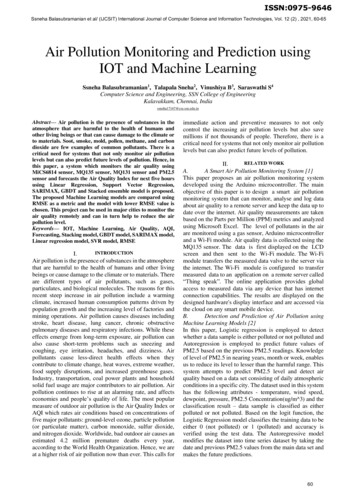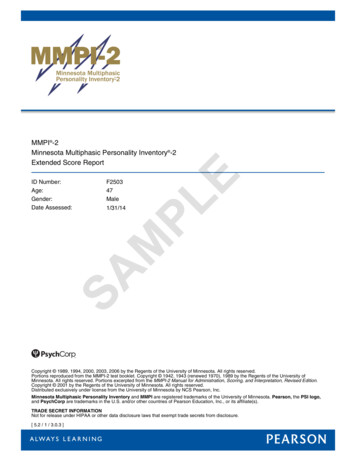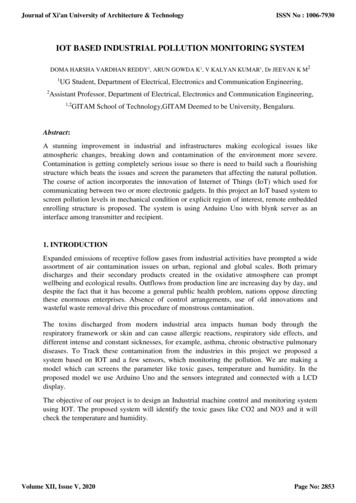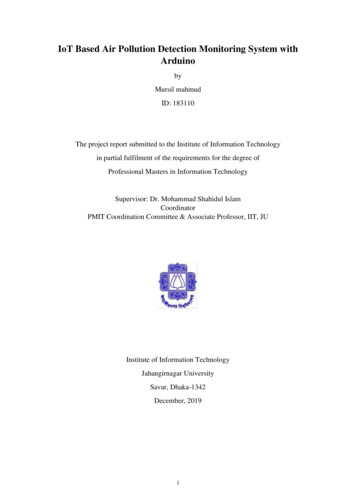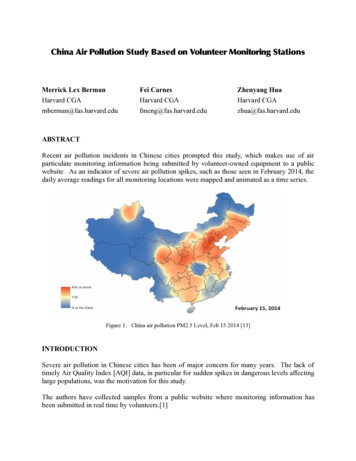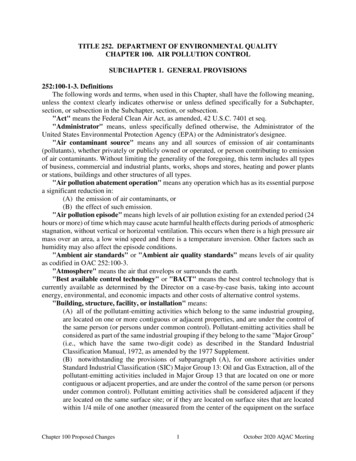
Transcription
TITLE 252. DEPARTMENT OF ENVIRONMENTAL QUALITYCHAPTER 100. AIR POLLUTION CONTROLSUBCHAPTER 1. GENERAL PROVISIONS252:100-1-3. DefinitionsThe following words and terms, when used in this Chapter, shall have the following meaning,unless the context clearly indicates otherwise or unless defined specifically for a Subchapter,section, or subsection in the Subchapter, section, or subsection."Act" means the Federal Clean Air Act, as amended, 42 U.S.C. 7401 et seq."Administrator" means, unless specifically defined otherwise, the Administrator of theUnited States Environmental Protection Agency (EPA) or the Administrator's designee."Air contaminant source" means any and all sources of emission of air contaminants(pollutants), whether privately or publicly owned or operated, or person contributing to emissionof air contaminants. Without limiting the generality of the foregoing, this term includes all typesof business, commercial and industrial plants, works, shops and stores, heating and power plantsor stations, buildings and other structures of all types."Air pollution abatement operation" means any operation which has as its essential purposea significant reduction in:(A) the emission of air contaminants, or(B) the effect of such emission."Air pollution episode" means high levels of air pollution existing for an extended period (24hours or more) of time which may cause acute harmful health effects during periods of atmosphericstagnation, without vertical or horizontal ventilation. This occurs when there is a high pressure airmass over an area, a low wind speed and there is a temperature inversion. Other factors such ashumidity may also affect the episode conditions."Ambient air standards" or "Ambient air quality standards" means levels of air qualityas codified in OAC 252:100-3."Atmosphere" means the air that envelops or surrounds the earth."Best available control technology" or "BACT" means the best control technology that iscurrently available as determined by the Director on a case-by-case basis, taking into accountenergy, environmental, and economic impacts and other costs of alternative control systems."Building, structure, facility, or installation" means:(A) all of the pollutant-emitting activities which belong to the same industrial grouping,are located on one or more contiguous or adjacent properties, and are under the control ofthe same person (or persons under common control). Pollutant-emitting activities shall beconsidered as part of the same industrial grouping if they belong to the same "Major Group"(i.e., which have the same two-digit code) as described in the Standard IndustrialClassification Manual, 1972, as amended by the 1977 Supplement.(B) notwithstanding the provisions of subparagraph (A), for onshore activities underStandard Industrial Classification (SIC) Major Group 13: Oil and Gas Extraction, all of thepollutant-emitting activities included in Major Group 13 that are located on one or morecontiguous or adjacent properties, and are under the control of the same person (or personsunder common control). Pollutant emitting activities shall be considered adjacent if theyare located on the same surface site; or if they are located on surface sites that are locatedwithin 1/4 mile of one another (measured from the center of the equipment on the surfaceChapter 100 Proposed Changes1October 2020 AQAC Meeting
site) and they share equipment. Shared equipment includes, but is not limited to, producedfluids storage tanks, phase separators, natural gas dehydrators, or emissions controldevices. Surface site, as used in this definition, has the same meaning as in 40 CFR 63.761."Carbon dioxide equivalent emissions" or "CO2e" means an amount of GHG emitted, andshall be computed by multiplying the mass amount of emissions, for each of the six greenhousegases in the pollutant GHG, by the gas' associated global warming potential (GWP) published inTable A-1 to subpart A of 40 CFR Part 98 - Global Warming Potentials, and summing the resultantvalue for each to compute a CO2e."Catalytic cracking unit" means a unit composed of a reactor, regenerator and fractionatingtowers which is used to convert certain petroleum fractions into more valuable products by passingthe material through or commingled with a bed of catalyst in the reactor. Coke deposits producedon the catalyst during cracking are removed by burning off in the regenerator."Combustible materials" means any substance which will readily burn and shall includethose substances which, although generally considered incombustible, are or may be included inthe mass of the material burned or to be burned."Commence" means, unless specifically defined otherwise, that the owner or operator of afacility to which neither a NSPS or NESHAP applies has begun the construction or installation ofthe emitting units on a pad or in the final location at the facility."Commencement of operation" or "commencing operation" means the owner or operatorof the stationary source has begun, or caused to begin, emitting a regulated air pollutant from anyactivity for which the stationary source is designed and/or permitted."Complete" means in reference to an application for a permit, the application contains all theinformation necessary for processing the application. Designating an application complete forpurposes of permit processing does not preclude the Director from requesting or accepting anyadditional information."Construction" means, unless specifically defined otherwise, fabrication, erection, orinstallation of a source."Crude oil" means a naturally occurring hydrocarbon mixture which is a liquid at standardconditions. It may contain sulfur, nitrogen and/or oxygen derivatives of hydrocarbon."Direct fired" means that the hot gasses produced by the flame or heat source come into directcontact with the material being processed or heated."Division" means Air Quality Division, Oklahoma State Department of EnvironmentalQuality."Dust" means solid particulate matter released into or carried in the air by natural forces, byany fuel-burning, combustion, process equipment or device, construction work, mechanical orindustrial processes."EPA" means the United States Environmental Protection Agency."Excess emissions" means the emission of regulated air pollutants in excess of an applicablelimitation or requirement as specified in the applicable limiting Subchapter, permit, or order of theDEQ. This term does not include fugitive VOC emissions covered by an existing leak detectionand repair program that is required by a federal or state regulation."Existing source" means, unless specifically defined otherwise, an air contaminant sourcewhich is in being on the effective date of the appropriate Subchapter, section, or paragraph of theserules."Facility" means all of the pollutant-emitting activities that meet all the following conditions:(A) Are under common control.Chapter 100 Proposed Changes2October 2020 AQAC Meeting
(B) Are located on one or more contiguous or adjacent properties.(C) Have the same two-digit primary SIC Code (as described in the Standard IndustrialClassification Manual, 1987)."Federally enforceable" means all limitations and conditions which are enforceable by theAdministrator, including those requirements developed pursuant to 40 CFR Parts 60 and 61,requirements within any applicable State implementation plan, any permit requirementsestablished pursuant to 40 CFR 52.21 or under regulations approved pursuant to 40 CFR Part 51,subpart I, including operating permits issued under an EPA-approved program that is incorporatedinto the State implementation plan and expressly requires adherence to any permit issued undersuch program."Fossil fuel" means natural gas, petroleum, coal, or any form of solid, liquid, or gaseous fuelderived from such material."Fuel-burning equipment" means any one or more of boilers, furnaces, gas turbines or othercombustion devices and all appurtenances thereto used to convert fuel or waste to usable heat orpower."Fugitive dust" means solid airborne particulate matter emitted from any source other than astack or chimney."Fugitive emissions" means, unless specifically defined otherwise, those emissions whichcould not reasonably pass through a stack, chimney, vent, or other functionally equivalent opening."Fume" means minute solid particles generated by the condensation of vapors to solid matterafter volatilization from the molten state, or generated by sublimation, distillation, calcination, orchemical reaction when these processes create airborne particles."Garbage" means all putrescible animal and vegetable matter resulting from the handling,preparation, cooking and consumption of food."Greenhouse gas" or "GHG" means the air pollutant defined in 40 CFR § 86.1818-12(a) asthe aggregate group of six greenhouse gases: carbon dioxide (CO2), nitrous oxide (N2O), methane(CH4), hydrofluorocarbons (HFCs), perfluorocarbons (PFCs), and sulfur hexafluoride (SF6)."Gross particulate matter" or "GPM" means particulate matter with an aerodynamicdiameter greater than 10 micrometers."In being" means as used in the definitions of New Installation and Existing Source that anowner or operator has undertaken a continuous program of construction or modification or theowner or operator has entered into a binding agreement or contractual obligation to undertake andcomplete within a reasonable time a continuous program of construction or modification prior tothe compliance date for installation as specified by the applicable regulation."Incinerator" means a combustion device specifically designed for the destruction, by hightemperature burning, of solid, semi-solid, liquid, or gaseous combustible wastes and from whichthe solid residues contain little or no combustible material."Indirect fired" means that the hot gasses produced by the flame or heat source do not comeinto direct contact with the material, excluding air, being processed or heated."Installation" means an identifiable piece of process equipment."Lowest achievable emissions rate" or "LAER" means, for any source, the more stringentrate of emissions based on paragraphs (A) and (B) of this definition. This limitation, when appliedto a modification, means the lowest achievable emissions rate for the new or modified emissionsunits within a stationary source. In no event shall the application of LAER allow a proposed newor modified stationary source to emit any pollutant in excess of the amount allowable underapplicable standard of performance for the new source.Chapter 100 Proposed Changes3October 2020 AQAC Meeting
(A) LAER means the most stringent emissions limitation which is contained in theimplementation plan of any State for such class or category of stationary source, unless theowner or operator of the proposed stationary source demonstrates that such limitations arenot achievable, or(B) LAER means the most stringent emissions limitation which is achieved in practice bysuch class or category of stationary sources."Major source" means any new or modified stationary source which directly emits or has thecapability at maximum design capacity and, if appropriately permitted, authority to emit 100 tonsper year or more of a given pollutant. (OAC 252:100-8, Part 3)"Malfunction" means any sudden, infrequent, and not reasonably preventable failure of airpollution control equipment, process equipment, or a process to operate in a normal or usualmanner. Failures that are caused in part by poor maintenance or careless operation are notmalfunctions."Mist" means a suspension of any finely divided liquid in any gas or atmosphere exceptinguncombined water."Modification" means any physical change in, or change in the method of operation of, asource which increases the amount of any air pollutant emitted by such source or which results inthe emission of any air pollutant not previously emitted, except that:(A) routine maintenance, repair and replacement shall not be considered physical changes;and,(B) the following shall not be considered a change in the method of operation:(i) any increase in the production rate, if such increase does not exceed the operatingdesign capacity of the source;(ii) an increase in hours of operation;(iii) use of alternative fuel or raw material if, prior to the date any standard under thispart becomes applicable to such source the affected facility is designed to accommodatesuch alternative use."National Emission Standards for Hazardous Air Pollutants" or "NESHAP" means thosestandards found in 40 CFR Parts 61 and 63."New installation", "New source", or "New equipment" means an air contaminant sourcewhich is not in being on the effective date of these regulations and any existing source which ismodified, replaced, or reconstructed after the effective date of the regulations such that the amountof air contaminant emissions is increased."New Source Performance Standards" or "NSPS" means those standards found in 40 CFRPart 60."New source review" or "NSR" means a process of evaluation performed by the DEQ todetermine the applicable requirements that must be incorporated into a construction permit issuedby the DEQ as necessary to authorize construction, modification, or change in the method ofoperation of a new or existing stationary source. DEQ’s NSR program, at a minimum, must meetthe requirements of 40 CFR Part 51, Subpart I."Nonmethane organic compounds" or "NMOC" means nonmethane organic compounds,as defined in 40 CFR 60.754."NSR permit" means a construction permit issued by the DEQ as necessary to authorizeconstruction, modification, or change in the method of operation of a new or existing stationarysource.Chapter 100 Proposed Changes4October 2020 AQAC Meeting
"Opacity" means the degree to which emissions reduce the transmission of light and obscurethe view of an object in the background."Open burning" means the burning of combustible materials in such a manner that theproducts of combustion are emitted directly to the outside atmosphere."Organic compound" means any chemical compound containing the element carbon."Owner or operator" means any person who owns, leases, operates, controls or supervises asource."Part 70 permit" means (unless the context suggests otherwise) any permit or group ofpermits covering a Part 70 source that is issued, renewed, amended, or revised pursuant to thisChapter."Part 70 program" means a program approved by the Administrator under 40 CFR Part 70."Part 70 source" means any source subject to the permitting requirements of Part 5 ofSubchapter 8, as provided in OAC 252:100-8-3(a) and (b)."PM10 emissions" means particulate matter emitted to the ambient air with an aerodynamicdiameter of 10 micrometers or less as measured by applicable reference methods, or an equivalentor alternative method."PM10" means particulate matter with an aerodynamic diameter of 10 micrometers or less."PM2.5" means particulate matter with an aerodynamic diameter of 2.5 micrometers or less."Particulate matter" or "PM" means any material that exists in a finely divided form as aliquid or a solid."Particulate matter emissions" means particulate matter emitted to the ambient air asmeasured by applicable reference methods, or an equivalent or alternative method."Potential to emit" means the maximum capacity of a source to emit a pollutant under itsphysical and operational design. Any physical or operational limitation on the capacity of thesource to emit a pollutant, including air pollution control equipment and restrictions on hours ofoperation or on the type or amount of material combusted, stored or processed, shall be treated aspart of its design if the limitation or the effect it would have on emissions is enforceable. Secondaryemissions do not count in determining the potential to emit of a source."Prevention of significant deterioration" or "PSD" means increments for the protection ofattainment areas as codified in OAC 252:100-3."Process equipment" means any equipment, device or contrivance for changing any materialsor for storage or handling of any materials, the use or existence of which may cause any dischargeof air contaminants into the open air, but not including that equipment specifically defined as fuelburning equipment, or refuse-burning equipment."Process weight" means the weight of all materials introduced in a source operation,including solid fuels, but excluding liquids and gases used solely as fuels, and excluding airintroduced for the purposes of combustion. Process weight rate means a rate established as follows:(A) for continuous or long-run, steady-state, operations, the total process weight for theentire period of continuous operation or for a typical portion thereof, divided by the numberof hours of such period or portion thereof.(B) for cyclical or batch source operations, the total process weight for a period whichcovers a complete or an integral number of cycles, divided by the hours of actual processoperation during such period.(C) where the nature of any process or operation or the design of any equipment is suchas to permit more than one interpretation of this definition, that interpretation which resultsin the minimum value for allowable emission shall apply.Chapter 100 Proposed Changes5October 2020 AQAC Meeting
"Reasonably available control technology" or "RACT" means devices, systems, processmodifications, or other apparatus or techniques that are reasonably available taking into account:(A) The necessity of imposing such controls in order to attain and maintain a nationalambient air quality standard;(B) The social, environmental, and economic impact of such controls; and(C) Alternative means of providing for attainment and maintenance of such standard."Reconstruction" means(A) the replacement of components of an existing source to the extent that will bedetermined by the Executive Director based on:(i) the fixed capital cost (the capital needed to provide all the depreciable componentsof the new components exceeds 50 percent of the fixed capital cost of a comparableentirely new source);(ii) the estimated life of the source after the replacements is comparable to the life ofan entirely new source; and,(iii) the extent to which the components being replaced cause or contribute to theemissions from the source.(B) a reconstructed source will be treated as a new source for purposes of OAC 252:1008, Part 9."Refinery" means any facility engaged in producing gasoline, kerosene, fuel oils or otherproducts through distillation of crude oil or through redistillation, cracking, or reforming ofunfinished petroleum derivatives."Refuse" means, unless specifically defined otherwise, the inclusive term for solid, liquid orgaseous waste products which are composed wholly or partly of such materials as garbage,sweepings, cleanings, trash, rubbish, litter, industrial, commercial and domestic solid, liquid orgaseous waste; trees or shrubs; tree or shrub trimmings; grass clippings; brick, plaster, lumber orother waste resulting from the demolition, alteration or construction of buildings or structures;accumulated waste material, cans, containers, tires, junk or other such substances.Refuse-burning equipment" means any equipment, device, or contrivance, and allappurtenances thereto, used for the destruction of combustible refuse or other combustible wastesby burning."Regulated air pollutant" means any substance or group of substances listed in Appendix Pof this Chapter, or any substance regulated as an air pollutant under any federal regulation forwhich the Department has been given authority, or any other substance for which an air emissionlimitation or equipment standard is set by an enforceable permit."Responsible official" means one of the following:(A) For a corporation: a president, secretary, treasurer, or vice-president of the corporationin charge of a principal business function, or any other person who performs similar policyor decision-making functions for the corporation, or a duly authorized representative ofsuch person if the representative is responsible for the overall operation of one or moremanufacturing, production, or operating facilities applying for or subject to a permit andeither:(i) The facilities employ more than 250 persons or have gross annual sales orexpenditures exceeding 25 million (in second quarter 1980 dollars); or(ii) The delegation of authority to such representatives is approved in advance by theDEQ;Chapter 100 Proposed Changes6October 2020 AQAC Meeting
(B) For the partnership or sole proprietorship: a general partner or the proprietor,respectively;(C) For a municipality, state, federal, or other public agency: Either a principal executiveofficer or ranking elected official. For purposes of this Chapter, a principal executiveofficer or installation commander of a federal agency includes the chief executive officerhaving responsibility for the overall operations of a principal geographic unit of the agency(e.g., a Regional Administrator of EPA); or(D) For affected sources:(i) The designated representative insofar as actions, standards, requirements, orprohibitions under Title IV of the Act or the regulations promulgated thereunder areconcerned; and(ii) The designated representative for any other purposes under this Chapter."Shutdown" means the cessation of operation of any process, process equipment, or airpollution control equipment."Smoke" means small gas-borne or air-borne particles resulting from combustion operationsand consisting of carbon, ash, and other matter any or all of which is present in sufficient quantityto be observable."Source operation" means the last operation preceding the emission of an air contaminant,which operation:(A) results in the separation of the air contaminant from the process materials or in theconversion of the process materials into air contaminants, as in the case of combustion offuel; and,(B) is not an air pollution abatement operation."Stack" means, unless specifically defined otherwise, any chimney, flue, duct, conduit,exhaust, pipe, vent or opening, excluding flares, designed or specifically intended to conductemissions to the atmosphere."Standard conditions" means a gas temperature of 68 degrees Fahrenheit (20o Centigrade)and a gas pressure of 14.7 pounds per square inch absolute."Startup" means the setting into operation of any process, process equipment, or air pollutioncontrol equipment."Stationary source" means, unless specifically defined otherwise, any building, structure,facility, or installation either fixed or portable, whose design and intended use is at a fixed locationand emits or may emit an air pollutant subject to OAC 252:100."Temperature inversion" means a phenomenon in which the temperature in a layer of airincreases with height and the cool heavy air below is trapped by the warmer air above and cannotrise."Title V permit" means (unless the context suggests otherwise) an operating permit for a Part70 source."Total Suspended Particulates" or "TSP" means particulate matter as measured by the highvolume method described in Appendix B of 40 CFR Part 50."Visible emission" means any air contaminant, vapor or gas stream which contains or maycontain an air contaminant which is passed into the atmosphere and which is perceptible to thehuman eye."Volatile organic compound" or "VOC" means any organic compound that participates inatmospheric photochemical reactions resulting in the formation of tropospheric ozone. Carbonmonoxide, carbon dioxide, carbonic acid, metallic carbides, ammonium carbonates, tert-butylChapter 100 Proposed Changes7October 2020 AQAC Meeting
acetate and compounds listed in 40 CFR 51.100(s)(1) are presumed to have negligiblephotochemical reactivity and are not considered to be VOC.252:100-1-4. Units, abbreviations, and acronyms(a) Abbreviations and symbols of units of measure.(1) Btu - British thermal unit(2) cm/sec - centimeter per second(3) CO2e - carbon dioxide equivalent(4) dscf - dry cubic feet at standard conditions(5) dscm - dry cubic meter at standard conditions(6) ft/min - feet per minute(7) gal - gallon(8) gal/d - gallons per day(9) gal/yr - gallons per year(10) gr/dscf - grains per dry standard cubic foot(11) hr - hour(12) Hg - mercury(13) hp - horsepower(14) H2O - water(15) H2S - hydrogen sulfide(16) H2SO4 - sulfuric acid(17) kg - kilogram(18) kg/metric ton - kilograms per metric ton(19) kPa - kilopascals(20) l - liter(21) l/yr - liters per year(22) LT/D - long tons per day(23) lb/wk - pounds per week(24) lb - pound(25) lbs/hr - pounds per hour(26) m3 - cubic meter(27) mg/dscm - milligrams per dry standard cubic meter(28) MMBTU/hr - million british thermal units per hour(29) Mg - megagram - 106 gram(30) Mg/yr - megagrams per year(31) mg/l - milligrams per liter(32) m/min - meter per minute(33) ng/dscm - nanograms per dry standard cubic meter(34) ng/J - nanograms per Joule(35) oz/in2 - ounce per square inch(36) ppm - parts per million(37) psia - pounds per square inch absolute(38) psig - pounds per square inch gage(39) ppmv - parts per million by volume(40) SO2 - sulfur dioxide(41) TPY - tons per yearChapter 100 Proposed Changes8October 2020 AQAC Meeting
(42) μg/m3 - micrograms per cubic meter(b) Acronyms.(1) A.I.S.I. - American Iron and Steel Institute(2) A.S.M.E. - American Society of Mechanical Engineers(3) A.S.T.M. - American Society for Testing and Materials(4) BACT - Best Available Control Technology(5) CEM - Continuous Emission Monitor(6) CFR - Code of Federal Regulations(7) COM - Continuous Opacity Monitor(8) DEQ - Department of Environmental Quality(9) EPA - Environmental Protection Agency(10) GHG - Greenhouse Gas(11) HAP - Hazardous Air Pollutants(12) HMIWI - Hospital/Medical/Infectious Waste Incinerator(13) MACT - Maximum Achievable Control Technology(14) MSW - Municipal Solid Waste(15) MWC - Municipal Waste Combustors(16) NAAQS - National Ambient Air Quality Standards(17) NESHAP - National Emissions Standards for Hazardous Air Pollutants(18) NSPS - New Source Performance Standards(19) NSR - New Source Review(20) (19) OAC - Oklahoma Administrative Code(21) (20) PBR - Permit by Rule(22) (21) PM - Particulate Matter(23) (22) PSD - Prevention of Significant Deterioration(24) (23) SIC - Standard Industrial Classification(25) (24) SIP - State Implementation Plan(26) (25) TSP - Total Suspended Particulates(27) (26) VOC - Volatile Organic Compound(28) (27) 27A O.S. - Title 27A Oklahoma StatutesSUBCHAPTER 7. PERMITS FOR MINOR FACILITIESPART 1. GENERAL PROVISIONS252:100-7-1.1. DefinitionsThe following words and terms when used in this Subchapter shall have the following meaningunless the context clearly indicates otherwise:"Actual emissions" means the total amount of any regulated air pollutant actually emittedfrom a given facility during a particular calendar year, determined using methods contained inOAC 252:100-5-2.1(d)."Best Available Control Technology" or "BACT" means the best control technology thatis currently available as determined by the Director on a case-by-case basis, taking into accountenergy, environmental, and economic impacts and other costs.Chapter 100 Proposed Changes9October 2020 AQAC Meeting
"Commence" means, as applied to the construction or modification of a minor facility towhich neither a NSPS or NESHAP applies, that the owner or operator has begun the constructionor installation of the emitting equipment on a pad or in the final location at the facility."De minimis facility" means a facility that meets the requirements contained in paragraphs(A) and (B) of this definition.(A) All the air pollutant emitting activities at the facility are on the de minimis listcontained in Appendix H or the facility meets all of the following de minimis criteria:(i) The facility has actual emissions of 5 tpy or less of each regulated air pollutant,except that fraction of particulate matter that exhibits an aerodynamic particulatediameter of more than 10 micrometers (µm).(ii) The facility is not a "major source" as defined in OAC 252:100-8-2.(iii) The facility is not a "major stationary source" as defined in OAC 252:100-8-31for facilities in attainment areas.(iv) The facility is not a "major stationary source" as defined in OAC 252:100-8-51for facilities in nonattainment areas.(v) The facility is not operated in conjunction with another facility or source that issubject to air quality permitting.(vi) The facility has not opted to obtain or retain an Air Quality Division permit.(B) The facility is not subject to the Federal NSPS (40 CFR Part 60) or the FederalNESHAP (40 CFR Parts 61 and 63)."Emergency engine" means a stationary engine used to resume essential operations or ensuresafety during sudden and unexpected occurrences including but not limited to loss of electricalpower, fire, and/or flood."Facility" means all of the pollutant-emitting activities that meet all the following conditions:(A) Are under common control.(B) Are located on one or more contiguous or adjacent properties.(C) Have the same two-digit primary SIC Code (as described in the Standard IndustrialClassification Manual, 1987)."Federally Enforceable State Operating Permit" or "FESOP" means an operating permitissued under Subchapter 7 of this Chapter, including operating permits issued under the provisionsof 252:4-7-33(a)(2). As such, for the purposes of this subchapter, “FESOP” and “operating permit”are synonymous."FESOP Enhanced NSR process" means a process under which the evaluation ofrequirements applicable under NSR is integrated with a determination of procedural andcompliance requirements under the DEQ’s FESOP program. This process is only available forfacilities already operating under a FESOP permit. Under a FESOP enhanced NSR process, the30-day public and EPA review period of an NSR permit is integrated with the review of the FESOPand results in the issuance of a minor source construction permit whose applicable FESOPimplications have also been reviewed. Later the requirem
"Crude oil" means a naturally occurring hydrocarbon mixture which is a liquid at standard conditions. It may contain sulfur, nitrogen and/or oxygen derivatives of hydrocarbon. "Direct fired" means that the hot gasses produced by the flame or heat source come into direct contact with the material being processed or heated.



